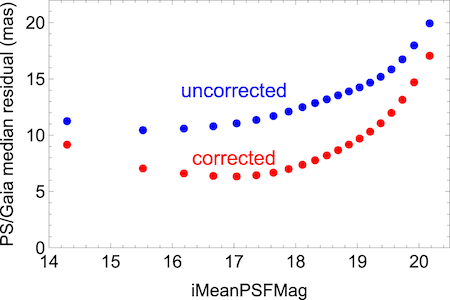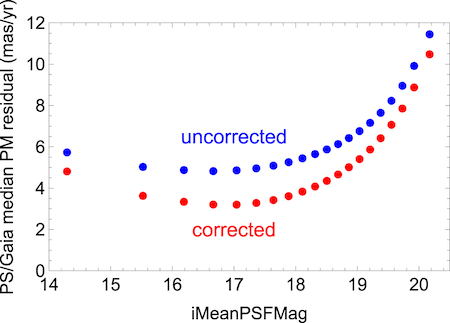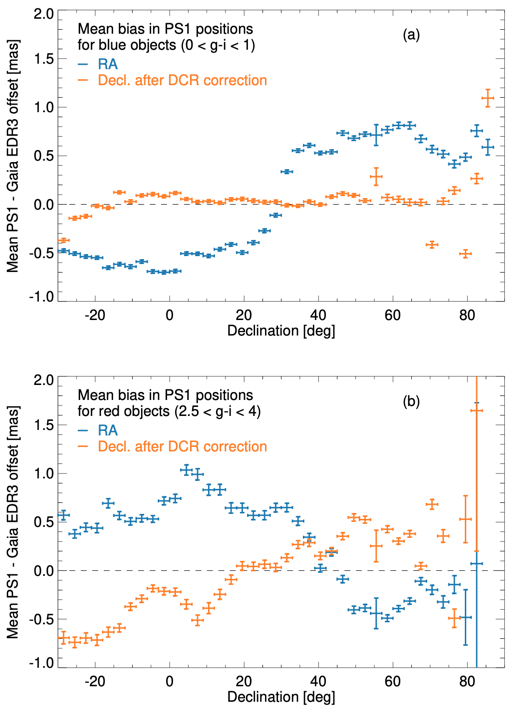Page History
Versions Compared
Key
- This line was added.
- This line was removed.
- Formatting was changed.
Two recent papers by Lubow, White & Shiao (2021) and White, Lubow & Shiao (2022) have described an algorithm for improving the Pan-STARRS1 astrometry using Gaia EDR3 to remove local coordinate distortions and developed an iterative algorithm for the removal of color-dependent effects from differential chromatic refraction (DCR). These algorithms have been applied to the PS1 catalog to calculate improved positions and newly calculated proper motions for 1.7 billion objects having at least 3 detections in PS1 single-epoch images. The updated astrometric information has been incorporated into the PS1 database.
| Tip | ||||||
|---|---|---|---|---|---|---|
| ||||||
|
Summary of Database Changes
The ObjectThin table's raMean, decMean and their associated error columns have been updated, and new columns have been added with proper motions (pmra, pmdec) and errors along with a new flags column astrometryInfoFlags. See the AstrometryCorrection table if access is required to the positions before the Gaia EDR3 corrections. However, for most users the new values are preferred.
Paper 1: Improvements to Pan-STARRS1 Astrometry Using Gaia
Lubow, White & Shiao (2021) used the Gaia DR2 catalog to improve the astrometric accuracy of about 1.7 billion objects in PS1 DR2, including objects with detections at 3 or more epochs. They also computed proper motions for these PS1 objects. A cross-match between Gaia and PS1 revealed residuals that are correlated on a scale of about 1 arcmin (see Fig. 1 below). A spatially adaptive correction algorithm using nearby PS1 objects that are also in the Gaia catalog reduces PS1/Gaia residuals by 33% in position (median value of 13.5 mas reduced to 9.0 mas) and by 24% in proper motion (median value of 6.3 mas yr-1 reduced to 4.8 mas yr-1). Systematic errors are improved by even larger factors since the remaining residuals are dominated by random measurement errors. The residuals for the corrected positions are smallest for objects with the most point-like morphologies and with intermediate magnitudes of about 17 mag (see Fig. 2 below). The residual errors in declination are systematically larger than those in R.A.; the declination errors increase with zenith angle in proportion to the air mass of the observations and depend on the colors of the stars.
|
| Figure 1: Systematic astrometric distortion as a function of position for a typical, moderately crowded PS1 field. The vectors show the median shifts between the PS1 and Gaia DR2 position in each cell; the scale for the vectors is shown at the lower right. Before the Paper 1 corrections (left panel), there are systematic, spatially variable distortions in the PS1 coordinates, with a mean shift of 12.7 mas. After correction (right panel), the remaining systematic distortions are small (<1 mas). The vector scale has been increased by a factor of two in the right panel to increase the visibility of the residuals. (Fig. 1 from Lubow, White & Shiao 2021) |
|
|
| Figure 2: Median PS1/Gaia DR2 position residuals in mas (left) and proper-motion residuals in mas/yr (right) as a function of PS1 i-band PSF magnitude for PS1 reference objects. Residuals are shown before (blue) and after (red) the Gaia correction. (Figs. 9 and 10 from Lubow, White & Shiao 2021) | |
Paper 2: Corrections for Differential Chromatic Refraction
After the correction procedure from Paper 1, the remaining declination positional residuals at a given decl. generally vary with color and declination in a way consistent with the effects of atmospheric differential chromatic refraction (DCR). White, Lubow & Shiao (2022) improved the algorithm by utilizing Gaia EDR3 and correcting for the effects of DCR in declination. They iteratively subtracted color- and declination-dependent PS1/Gaia EDR3 declination residuals. Across the entire catalog, the astrometric improvement is relatively modest (about 8%). But the improvement is dramatic for objects with unusual colors observed away from the zenith. DCR corrections lead to an astrometric improvement of ~30% for blue objects (0<g-i<1) that are 50° away from the zenith. The amplitude of systematic astrometric errors from these effects is substantially reduced to less than 1 mas for objects with PS1 colors in the range 0 < g-i < 4.5 (see Fig. 3 below and the figure at the upper right), which makes this version of PS1 a much more useful astrometric reference catalog in fields where there are few Gaia stars.
|
Figure 3: Mean positional bias in PS1 catalog positions compared with Gaia as a function of sky position for blue stars (left column) and red stars (right column). The top row shows the decl. offset before the DCR correction, and the middle row shows the decl. offset after the DCR correction. The bottom row shows the offset in RA, which is not changed by the DCR correction. The same scale is used for all panels. The dramatic north-south difference in the top plot is the DCR effect corrected by Paper 2; after the correction (middle row) the errors are small except for small regions near the Galactic plane (where blue stars are very rare and crowding is severe). The faintly seen difference between higher and lower declination regions in the RA plot (bottom row) is due to additional uncorrected DCR effects. However, its small amplitude (< 1 mas), combined with the complex nature of an algorithm to correct it, led us not to attempt a DCR correction for the RA. (Fig. 10 from White, Lubow & Shiao 2022) |
| Divbox | ||
|---|---|---|
| ||
|





